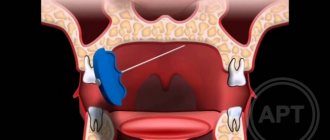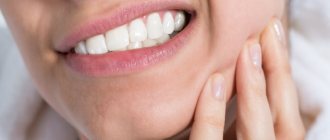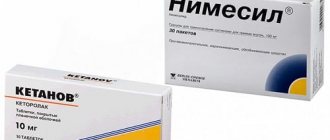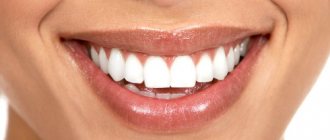The tooth hurts badly. Each of us has had to deal with this unpleasant situation more than once or twice. Many regular patients of the dental clinic already independently differentiate pain due to caries from pain due to pulpitis.
If pain occurs spontaneously, intensely, and worsens at night, they will rush to the dentist the next morning, and if pain arises from external irritants and indicates the development of deep caries, they will allow themselves to postpone treatment for a couple of days. But what to do when all your teeth hurt at once? First, let's figure out why we feel toothache in the first place.
Diagnosing the problem at home
Sometimes, to understand which tooth hurts, it is enough to look into your mouth. You need to go to the mirror and conduct a visual inspection. The diseased element may be damaged, with dark spots and depressions. There are also signs that indicate a problem: chipped, worn, cracked or transparent enamel, the presence of pustules and seals on the mucous membrane, inflamed, swollen or bleeding gums.
It also happens that a visual inspection reveals nothing. For example, when the problem develops under an artificial crown or filling. In this case, light pressure on the crowns or gently tapping them with the tip of a teaspoon will help determine the source of the pain.
How else can you find out which tooth hurts? During eating, pieces of food can become lodged in an element destroyed by dental diseases; it is difficult not to feel it. Hard tissues in the area of the pathological process can react to food temperature and mechanical stress during hygiene procedures.
On a note! If you want to understand which tooth hurts, then take the diagnostic question seriously. Before examination, remove soft plaque and food debris from your mouth. The room where the inspection is being carried out should have good lighting. Carefully examine every visible surface of the tooth using a mirror, and also check your gums for inflammation.
How to relieve toothache?
When teeth ache, the dentists of our clinic recommend that their patients take the necessary painkillers and immediately seek advice from a specialist. And the main thing is not to use widely known methods of pain relief, such as: applying ice to a sore tooth, putting an iodine net, disinfecting with vodka or rinsing with sage or applying a compress. All these “tips” can significantly worsen the situation.
However, remember that even if the toothache was relieved, it will soon return, because the cause that caused it is still not eliminated and requires medical intervention.
We determine the cause of pain by the nature of the sensations and accompanying symptoms
In most cases, checking which tooth hurts on your own is not difficult. It is more difficult to establish why the discomfort and discomfort appeared. It all depends on the accompanying symptoms.
| Possible reason | Associated symptoms |
| Increased sensitivity of enamel | Thin, transparent enamel, with cracks and chips. Reaction to cold and hot, sour, sweet. Discomfort due to mechanical impact. Often pain occurs not in one, but in several teeth at once or along an entire row |
| Caries | Reaction to food temperature and mechanical stress. The discomfort goes away almost immediately after the irritating factor is eliminated, but as the disease progresses, the pain persists longer. First, white chalky spots appear on the enamel, then black dots, depressions and pits into which food easily gets clogged. |
| Pulpitis | The pain is acute and prolonged, persists for a long time after the removal of the stimulus, can occur involuntarily, and “spread” to all parts of the face and head. Unpleasant sensations intensify at night. With pulpitis, the enamel of the diseased tooth may darken |
| Periodontitis | May occur under a filling or crown. Sharp pain appears when pressing or chewing solid food. With this disease, there is a feeling of fullness and pressure in the inflamed area. The root of the diseased unit may begin to wobble |
| Flux, abscess, cyst | The gums around the diseased element become inflamed, and ulcers, pimples, and lumps may appear on the mucous membrane. In acute and advanced stages, swelling of the soft tissues of the face occurs. Unpleasant sensations intensify during tapping and pressure on the sore area |
| Fistula | An ulcer or pimple on the gum that may ooze fluid or pus. Unpleasant taste and odor in the mouth |
| Root fracture, crack, trauma | Sharp and acute pain, the tooth becomes mobile, it is impossible to chew food on it |
| Periodontal inflammation | If it is not clear which tooth hurts, then it may not be about the tooth at all, but about the periodontal tissues. So, with gingivitis or periodontitis, the mucous membrane itches and becomes inflamed, and also bleeds, and this process is most often generalized (applies to the entire jaw). At advanced stages of periodontitis, the roots become exposed and the teeth become mobile and begin to respond to thermal and mechanical stress. |
| Previously performed poor-quality treatment | If you just recently visited the dentist, and after that the treated tooth began to ache, then in the first 2-4 days this situation can be considered normal. In most cases, this indicates a tissue reaction to various medications and surgical intervention. With each subsequent day, the discomfort should decrease, but if it becomes stronger, this may indicate medical errors made during treatment. |
“I don’t advise anyone to guess on the coffee grounds and independently identify various diseases. In general, I never know which tooth hurts me, because the sensations are always ambiguous. The other day, there was a situation: my upper jaw was aching, and I was sure that the problem was there, although visually everything was normal everywhere. Even when I went to the doctor, I indicated a specific area, but the dentist looked and said that this was not so. As a result, the lower filled molar turned out to be problematic, under which secondary caries developed, and it was treated.”
Katerina, review from the dental portal gidpozubam.ru
Physiological processes
The most common factors that cause pain at night are physiological. Most often, this phenomenon is caused by a horizontal position taken during rest. In this position, blood flows intensely to the head, brain and jaws, which increases pressure on the inflamed tissues and nerve endings of the teeth. It should be noted that this process is not typical for all dental diseases. The most common cause of acute and severe toothache at night is pulpitis. At this time of day, excessive pressure forms in the inflamed pulp due to increased blood flow, and bundles of nerve fibers begin to send active signals to the central nervous system. Excruciating pain, mainly at night, can also occur with periodontitis and periodontitis.
The whole jaw aches: what does this mean?
Many patients, when visiting a doctor, complain that their entire jaw ache, but after examination it turns out that one tooth is to blame. Why is this happening? With some pathologies, pain can radiate (give) to different parts of the face and head: jaw, temple, ear, eyes. This often happens with pulpitis, eruption of wisdom teeth, the presence of impacted and dystopic elements in the jawbone that grow in the wrong direction, put pressure on their neighbors or do not break out at all. Pain can radiate to different areas if the disease is in an acute stage or the patient has advanced pathology.
On a note! Does your entire jaw ache after tooth extraction? This situation is also not uncommon, especially if the extraction was difficult and traumatic, or occurred against the background of a cyst or abscess. To ensure that the discomfort quickly disappears, strictly follow all the doctor’s recommendations. If improvements do not occur after 5-7 days, and alarming signs intensify, then contact your dentist immediately.
The entire jaw may ache if the patient has a malocclusion, since against the background of this problem the maxillofacial apparatus or its individual areas are overloaded, and teeth wear out, wear out and are destroyed ahead of schedule. Discomfortable sensations radiating throughout the entire jaw can also occur during bite correction with orthodontic devices, but many patients admit that these are temporary difficulties, because after a period of adaptation to braces or trainers, the situation normalizes.
Physiological factors
A separate group of reasons why patients experience toothache at night includes physiological factors:
- The time interval is from 00 o'clock to 5 am. This period of time is the most stressful and difficult for the entire human body. It is at this time that pain intensifies and sensitivity to any lesions and diseases, including dental ones, increases.
- Physiologists say that at night the vagus nerve called the vagus is activated, which has a large number of branches, some of which extend to the head area. The vagus affects the general condition and mood of a person. At night, the tone of the vagus nerve changes, which leads to increased sensitivity and pain.
- Also, based on the characteristics of the biorhythm, at night, even in a healthy person, blood pressure increases significantly. High blood pressure increases toothache.
If teeth have nothing to do with it
Sometimes it is not clear which tooth hurts. It may even seem like everything hurts at once. But dental disease is not always the cause. Similar symptoms may indicate other problems:
- inflammation of the trigeminal nerve,
- cancerous tumors in the oral cavity,
- ENT diseases: sinusitis, sinusitis, otitis media,
- hypothermia,
- salivary stone disease,
- dysfunction of the temporal mandibular joint,
- pathologies of the cardiovascular system: for example, angina pectoris,
- intervertebral hernia, pinched cervical nerve,
- psychosomatic state of a person: it may simply seem to you that your teeth are aching, especially if you have recently suffered stress,
- Jaw Fracture: Discomfort may occur even years after you have been treated. Some people note that in this way the body and the bones that have grown together after injury react to changing weather.
It is important to understand that internal diseases of the body can aggravate dental problems or contribute to their occurrence, just as, conversely, diseased teeth can cause other pathologies, such as sinusitis. This occurs due to the fact that infections from the source of inflammation can freely penetrate into all adjacent areas.
General conditions
Existing or past diseases manifest themselves in the form of various inflammations and diseases of the oral cavity, teeth and gums.
- If in childhood you suffered from severe flu or measles, then in adulthood this can result in diseases of the periodontium (periodontitis, periodontal disease) and teeth (pulpitis).
- If your body suffers from a lack of water or it is difficult to remove it from the body, do not be surprised by bleeding and gum inflammation.
- Vitamin deficiencies, especially a lack of vitamin C, are the cause of loosening and even tooth loss.
- Diseases of the gastrointestinal tract manifest themselves in the form of a whitish coating on the tongue, cracks and inflammation of the tongue.
Methods for diagnosing problems in dentistry
Regardless of whether it is clear or unclear to you which tooth hurts, the first thing to do when an alarming symptom occurs is, of course, to consult a doctor. The specialist will not only accurately diagnose, but also cure the disease that caused the problem. Otherwise, after a short period of time you will notice that not just one, but several nearby units are aching, as the infection has spread further.
Today in dentistry there are many diagnostic methods, one of the informative ones is x-ray examination. To determine the condition of the entire jaw system, roots, root canals and bone tissue, as well as to identify hidden problems, for example, fractures and cracks of the root, cysts and granulomas, the presence of dystopic and impacted teeth, doctors prescribe a two-dimensional panoramic image of the jaw or CT (computed tomography) . The second type of examination - computed tomography - is more accurate, as it allows you to obtain three-dimensional 3D images and examine all processes in great detail.
In addition to X-rays, the doctor will definitely conduct a visual examination using a mirror, percussion1 (tapping on the crown) and examination of the oral cavity using special instruments (dental probe). Additionally, electroodontodiagnosis may be prescribed to determine the viability of the pulp, color and thermal tests to identify various non-carious (hypoplasia, wedge-shaped defect) and carious pathologies.











